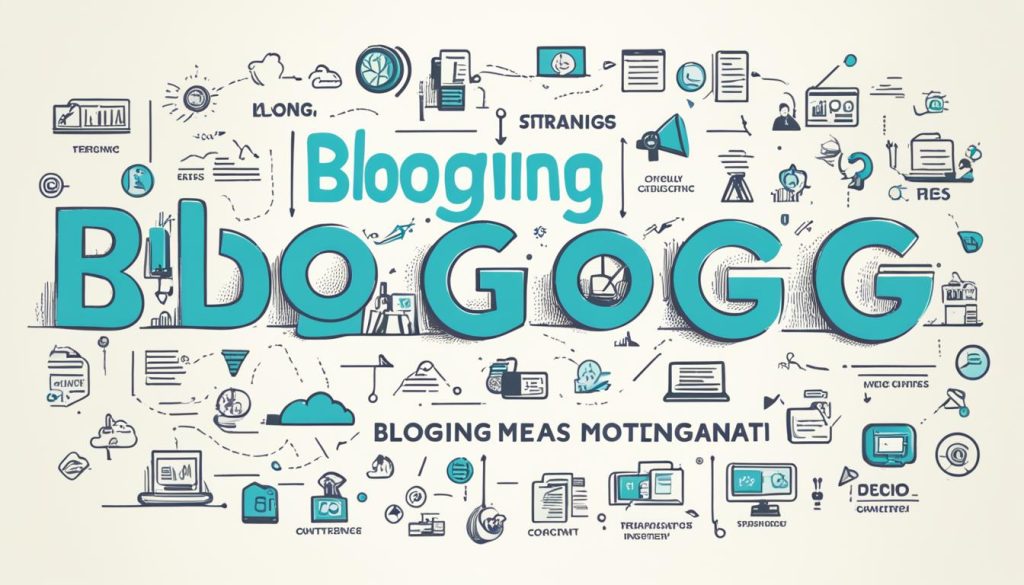Having trouble drawing in new readers to your blog? Not seeing your views turn into comments or shares? You might need to think about changing up your blogging strategy.
Now, here’s something to think about: 60% of businesses make a plan for their online content. But, guess what? Only 32% think their plan actually works. [source]
Today, in a world full of digital content, a strategy that’s clear and can change is key. This is vital for your blog’s success. But, figuring out when and how to change can be tough.
In this article, I’ll walk you through how to spot when it’s time for a content strategy update. I’ll share advice from top bloggers. Plus, I’ll give you practical steps to make a change that helps your blog grow. Let’s get started!
Why Beginners Bloggers Quit Too Early
Many beginner bloggers quit early because they don’t see blog success right away. But it takes time to build a successful blog. Patience is key.
Starting a blog is rewarding but has its challenges of blogging. Writing and managing a website can be overwhelming. Stay motivated to beat these hurdles.
Successful bloggers know that real success takes time. They focus on long-term goals, not quick wins. Staying persistent helps them overcome the first obstacles and find blog success.
Discovering Inspiration from Successful Bloggers
Find inspiration in well-known bloggers who’ve made it. Read about their journey and how they grew, facing challenges. Their stories can guide and inspire you.
Experienced bloggers share their wisdom through blogs, podcasts, and courses. These resources teach important blogging tips and motivate you. Learning from them can boost your confidence.
| Challenges of Blogging | Ways to Stay Motivated |
|---|---|
| 1. Building an audience | 1. Set realistic short-term and long-term goals |
| 2. Generating consistent content ideas | 2. Celebrate small wins along the way |
| 3. Overcoming writer’s block | 3. Create a supportive blogging community |
| 4. Dealing with negative feedback | 4. Seek inspiration from successful bloggers |
| 5. Balancing blogging with other commitments | 5. Take breaks and practice self-care |
Starting a blog will be tough, but quitting is not the answer. Learn from experts and keep your eyes on the prize. With hard work and focus, success is achievable.
The Beauty of Pinterest in Blog Growth
If you’re looking to drive fast traffic to your blog, Pinterest is great. It’s quicker than Google to show results. It can be a big help for bloggers while they work on getting seen in search engines.
Pinterest’s key point is how it focuses on visuals. This lets bloggers present their content in appealing ways. When bloggers make eye-catching pins, they draw in users that are browsing. Users may stop, look, and start reading the story behind the images.
But Pinterest does more than just look pretty. It’s also great at sending traffic to blogs. When someone finds a pin interesting and clicks to the blog, traffic gets a big boost. This spike in visitors can really help, especially for new blogs.
Pinterest is also good at making your blog more visible. Every pin can lead people back to the blog, making it seen more. Plus, when people save or share your pins, it reaches more eyes. This visibility growth can bring more followers and traffic.
A key benefit is how Pinterest supports blog optimization. By smartly using keywords in pins, more people can find your content. This simple step can increase your blog’s visibility. More visibility means more potential visitors.
Pinterest’s unique qualities can really grow your blog. Its visual appeal, traffic-driving power, and optimization chances are a blogger’s dream. Using Pinterest’s beauty, bloggers reach more people and grow their blogs faster.

Content Marketing Strategy Pivots for Sustained Growth
A strong content marketing plan is key to expanding your blog. With the changing digital world, you need to adjust your strategy for lasting growth. This means knowing what your readers want and making content that’s interesting or useful. This draws more people in and keeps them around.
Trying new ways to create content is a good move. You might want to make videos, podcasts, or fun stuff people can interact with. Mix up your content to reach more folks and give them something different. This can inspire loyalty in your readers.
It’s also important to keep an eye on what’s hot in your area. Watch the news and listen to what people talk about online. That way, you can jump on new topics and make blog posts that are timely. This makes your blog up-to-date and helps you stand out as an expert.
Another great strategy is breathing new life into old content. Look at your most-read blog posts and see how you can make them even better. You could turn them into videos, for example. Or make infographics, or even write a book about a popular subject. This can attract more people to your blog.
Plus, working with other creators in your field can do wonders. Joining forces with influencers or experts gives your blog more visibility. You could write for each other’s blogs, host online events together, or team up on social media. This makes your work more visible and brings in new ideas too.
To wrap it up, adapting your content plan is vital for growth in our fast-changing online world. By meeting your readers’ needs, trying new content ideas, and watching current trends, you can keep gaining followers. Don’t forget to update your past content and work with others to reach more people and add fresh ideas to your blog.
Tips for Pivoting Your Content Marketing Strategy
| Tips | Description |
|---|---|
| 1. Research Audience Needs | Understand what your audience wants and likes to make content that speaks to them. |
| 2. Experiment with Formats | Try out various content types to appeal to a wider range of tastes. |
| 3. Stay Current with Trends | Keep an eye on the latest news and online chatter to spot new trends in your area. |
| 4. Repurpose Existing Content | Turn your most popular content into something new and engaging, like videos or infographics. |
| 5. Collaborate with Others | Work with influencers or experts by sharing blogs or hosting webinars together to reach more people. |
How to Pivot Your Blogging Content Strategy
Pivoting your content strategy needs your audience in mind. Craft content that solves their issues and keeps them entertained. This makes your blog more engaging for readers. Learn about blog optimization techniques and blog SEO tactics. These will guide you through the pivot.
1. Define Consistency
Being consistent in blogging is crucial. But remember, it’s not about posting non-stop. Understand what being consistent means to your brand and followers. Think about when and how often you should post for the best impact. This helps you plan and use your resources wisely.
2. Address Pain-Points
To pivot, focus on content that hits your audience’s pain-points. Start by understanding their needs through research. Create blog posts that offer practical or inspirational advice. This shows you understand and care, helping you connect with readers.
3. Optimize for SEO
Using blog SEO tactics is key to ranking higher in search results. Do your keyword research. Use these words naturally in your posts. Also, tweak your meta tags, headings, and image descriptions. This will boost your blog’s visibility online. Focus on creating top-notch, helpful content for even better SEO results.
4. Diversify Content Types
To keep readers engaged and reach new ones, mix up your content. Try various formats like articles, infographics, or videos. This approach is more inclusive and lets you share content in more ways.
5. Analyze and Iterate
Always check how your blog is doing to see if your pivot is working. Use tools to track traffic, engagement, and social shares. Notice what content works well and what needs fixing. Then, adjust your strategy based on what the data tells you.
6. Stay Informed
Stay updated with blogging trends to lead the pack. Subscribe to newsletters, follow experts, and join communities. This way, you’ll learn new techniques and stay ahead. Always be ready to improve your skills and knowledge for your blog’s success.
| Blog Optimization Techniques | Blog SEO Tactics |
|---|---|
| Keyword research and integration | Implementing meta tags and optimizing headings |
| High-quality, informative content creation | Optimizing image alt attributes |
| Diversifying content types and formats | Tracking and analyzing performance metrics |
| Empathy-driven content creation | Staying informed about industry trends |
Key Considerations for Content Strategy Pivots
Thinking about a content strategy change? You should first look at how well your current strategy is doing. If it’s not meeting your goals, it might be time to switch things up.
Start by setting your pivot’s goals. What are you trying to do with your new strategy? Maybe you want more people to visit your site, or you’re looking to connect better with your audience. It’s important to be clear about your goals.
Next, think about where you share your content. Do you post mostly on your blog, or are you active on social media or emails too? Figuring out what platforms work best for you is key.
It’s crucial to keep track of how well your new strategy is doing. Pick some key numbers to follow, like how many people visit your site or if they share your posts. Watching these numbers can tell you if your changes are working.
Make a solid plan and stick to it. Lay out what you need to do and when. Deadlines and progress checks will keep things moving smoothly.
Don’t forget the tech. Using the right tools can make your strategy change go much more smoothly. You’ll need tools for managing content, tracking data, and scheduling posts.
Advantages of Digital Content Strategy Tools
Digital tools can be a big help in shifting your strategy. They offer insights into what your audience likes and doesn’t like. With their help, you can make smarter decisions based on data, not just guesses.
Forbes points out the benefits of these tools. They can help you find the right keywords, check out the competition, and plan your content better. Using them can give you an advantage and back up your changes with solid facts.
Implementing a Data-Driven Approach
When changing your content strategy, go with what the data tells you. It’s smarter to base your decisions on how things are really going, not just guessing. Look at your current content, what your audience likes, and what trends are out there.
Start with a content audit. This helps see what’s working and what’s not. Also, look at what your audience enjoys. This info can guide you in creating content that really speaks to them.
Keep an eye on how your new strategy is doing. Use data from your tools to see what’s working and what’s not. This way, you can keep rearranging your content to make it the best it can be.
Understanding When to Pivot Your Blogging Content Strategy
Knowing when to change your blog’s content is key for more growth. Bloggers must watch for content trends to keep their readers interested. But when is it the right time to switch things up?
There are signs that show a pivot might be needed. For example, if people aren’t as engaged, like not commenting or sharing, it could be time for a change. Also, if your posts don’t rank as high on search engines as they used to, it’s a flag to rethink your strategy.
If you see fewer people visiting your site, or if sales are flat, something needs to change in your strategy. It’s another sign that you’re not connecting with your readers well.
Additionally, if the words you use don’t get much search traffic anymore, it’s a sign to try new topics. This could mean your audience is looking for something different.
Try a content audit to find the gaps in your strategy. This means looking closely at what you’ve already published. It helps you see what’s not working and where you can improve.
After acknowledging the need for change, make sure to update your strategy to meet current trends and fix any issues. Keep an eye on what your readers like and adjust your topics as needed. This is how you keep your blog growing and keep your readers coming back.
Being aware of when to change your content strategy and giving what your readers want is important for your blog’s success. Be ready to change your plans when needed. This will move you closer to meeting your blogging goals.

Source: https://www.mtrmarketing.com/blog/pivoting-your-marketing-strategy-when-and-how-to-do-it-right
Tips for Successfully Pivoting Your Blogging Content Strategy
Changing your blogging content strategy can boost your blog’s growth. It’s important to do it right. Here are some tips to help:
1. Put Your Audience First
Prioritize your audience’s needs and interests when you change your strategy. Do research to understand what they like. Figure out their problems and focus on solving them with your content.
2. Utilize Analytics Tools and Gather Insights
Use analytics tools to learn about your audience’s behavior and preferences. Look at the data closely. Also, talk to people in sales and customer service to hear what customers want. This helps shape your new content to meet their needs better.
3. Set Measurable Goals and Track Progress
Have clear goals before you start changing things. Pick indicators for success like more site visits or better engagement. Keep an eye on your progress and adjust as needed to meet your goals.
4. Keep Your Customers Informed
Tell your readers about the changes and what they can expect. Use email, social media, or blog posts to keep them in the loop. Good communication avoids confusion and builds trust.
5. Gradually Implement Changes
Change slowly to avoid shocking your readers. Start with small updates and see how they do. Based on feedback and data, adjust slowly to make transitioning easier for everyone.

By using these suggestions, you can smoothly change your blog’s content strategy. Always remember to focus on your readers, use insights from analytics, set clear goals, communicate changes well, and make adjustments slowly. Doing these right can lead to long-term growth for your blog.
The Importance of Content Lens in Content Strategy Pivots
When you change your content strategy, the way you look at things matters a lot. Adjusting your view helps you dive deeper into what your audience cares about. This, in turn, makes your connections with them stronger.
Consider the tone and message of your content
Shifting your content strategy means thinking about the emotions and ideas in what you share. Make sure your content is kind and related to your audience. Speaking in a way that your audience understands can make your link with them more powerful. This approach can also make people interact with your content more.
Deliver timely and valuable content
Changing your content lens means offering content that’s both helpful and right on time. Keep an eye on what’s new in your area and meet your customers’ current needs. This strategy helps you become someone people trust for good advice. It also keeps your readers interested in what you share.

Address the needs of your customers
Every time you adjust your content plan, think about what your audience really needs. Find out what’s bothering them or what they find tricky. Create content that answers their questions and gives them valuable new ideas. This way, you’ll attract more people and keep them coming back.
Build stronger relationships
Changing how you see your content can pull your audience closer. By sharing what matches their passions and what they need, you create real bonds. Ask your readers what they think and listen to them. This step helps make your connections even stronger.
| Benefits of Content Lens in Strategy Pivots | How it Helps |
|---|---|
| Increases audience engagement | By addressing the needs of your audience, you can increase their engagement with your content. |
| Builds trust and credibility | By focusing on empathy and delivering valuable content, you can establish trust and credibility with your audience. |
| Drives organic traffic and SEO | Optimizing your content lens for SEO helps in attracting organic traffic and improving search engine rankings. |
| Fosters audience loyalty | Creating content that addresses their needs and interests helps in fostering audience loyalty and repeated engagement. |
Understanding the value of looking at your content differently is key. It helps you craft a strong strategy that meets your audience’s interests and needs. By showing empathy, offering valuable insights, and truly knowing your customers, you can form strong, lasting connections. These relationships are crucial for growing your blog over time.
Collaborating with Colleagues for Effective Content Strategy Pivots
Collaborating with colleagues is key when you want to shift your content strategy. They offer insights that can guide your decisions. Sales and customer service teams can tell you what your customers really want and need. This understanding shapes how you pivot your content strategy to meet their changing needs.
Taking time to research and understand your audience’s behavior is vital. Look at data like website analytics and social media interactions to spot trends. This approach ensures your decisions are based on what your audience likes and wants.
Building a detailed plan with your colleagues is crucial. Together, you can generate new ideas and trends and align your goals. This ensures that your strategy is balanced, considering everyone’s viewpoint.
Keep talking during the whole process. Update your team on how your pivot is going and ask for their thoughts. Their feedback can help you adjust your strategy and spot any mistakes you might overlook.

Benefits of Collaborating with Colleagues
Working with colleagues has many advantages for your content strategy changes. It merges various viewpoints and skills, making for a richer plan. Using your team’s knowledge can give your strategy a strong, new direction.
It also makes everyone feel they have a part in the change. With all hands on deck, people are more motivated to ensure the strategy’s success. This boosts morale and can improve the outcome.
But most importantly, teamwork like this strengthens the bonds within your team and your company’s culture. By aiming for the same goal, you solidify a spirit of cooperation and spark future work together.
So, working closely with your sales and customer support teams can really lend a hand in content strategy transformations. Reach out to your colleagues, gather your insights, and strategize effectively for a successful pivot.
Learn more about optimizing your business blog results
Avoid Overestimating Your Blogging Content Pivot
When pivoting your blog content, careful planning is key. Avoid huge changes that might confuse your readers. Pivoting can help you grow and adapt, but it must match your brand and what your audience wants.
Instead of a big change, tweak your content strategically. Strengthen your current work and fix what’s not working for your readers. This keeps your blog’s voice consistent but evolving.
It’s crucial to keep your brand’s essence when changing content. Make changes that follow your brand’s values and voice. This ensures a smooth shift for your readers.
Checking your progress and hearing what your readers think is vital during a pivot. Watch how engaged your readers are and if they take action. Use this feedback to make your blog even better.
Don’t think your blog pivot will work magically. Stay focused on what your readers need and your brand’s values. This approach will keep your readers interested and loyal.
Key Considerations for a Successful Blogging Content Pivot
| Consideration | Description |
|---|---|
| Alignment with Brand | Ensure that your content reflects your brand identity and values throughout the pivot process. |
| Gradual Implementation | Implement changes gradually to avoid overwhelming your audience and facilitate a smooth transition. |
| Evaluation and Optimization | Regularly evaluate the results and gather feedback to make data-driven decisions for further optimization. |

By following these key considerations and a smart approach to your blog pivot, you’ll do well. Aim for lasting growth and reader engagement on your blog.
For more on effective content marketing strategies, check this article on understanding startup pivots.
The Long-Term Benefits of Blogging Content Strategy Pivots
Pivoting your blogging strategy has many long-term advantages. Your blog can attract more readers by responding to their needs. It is important to always check if your strategy matches the latest trends and audience wishes.
These shifts can help your blog grow steadily over time. By using tips on blog growth and creating better content, you can improve how well your blog does. This could lead to more people visiting and enjoying your blog.
If you’re looking to change how you do things, remember that blogging changes quickly. Being open to new ideas keeps your blog useful and interesting. This way, your blog stays connected with the people who read it.
Attracting a Larger Readership
Changing your strategy can help bring more people to your blog. By creating content that speaks to your audience’s interests, you can get their attention. Following blog growth advice, such as making your blog easy to find online and sharing it on social media, can also help.
Using good storytelling and visuals makes your blog more enjoyable. This can keep readers coming back for more. Making valuable and engaging posts will help you gain a loyal following.
Improved Engagement and Interaction
Changing your approach can make your readers more involved. Crafting discussions through your content can encourage interaction. Including calls to action and other interactive parts in your posts can boost engagement too.
Making your blog easy to read and navigate leads to a better experience. This helps readers enjoy your content more. As a result, they may share or comment on your posts, reaching even more people.
Establishing Thought Leadership and Authority
A new content strategy can make you a trusted figure in your field. Sharing unique insights sets you apart from others. It helps build your credibility. Focusing on high-quality content can further establish you as an expert.
Working with big industry names can also increase your blog’s reach. It makes your blog a primary source of information. This could lead to more business and collaboration opportunities.
Increased Monetization Opportunities
Adapting your strategy can also help turn your blog into a source of income. A bigger audience and more engagement make your blog more appealing to sponsors. Including ads or working with relevant brands can help you make money.
Good content and a solid readership can attract even more ways to earn. This could include sponsored posts, affiliate marketing, or product partnerships. These avenues can support your blog’s growth and make it a sustainable venture.
| Benefits of Blogging Content Strategy Pivots | SEO Relevant Keywords |
|---|---|
| Attracting a Larger Readership | blog growth tips, content creation strategies |
| Improved Engagement and Interaction | blog growth tips, content creation strategies |
| Establishing Thought Leadership and Authority | blog growth tips, content creation strategies |
| Increased Monetization Opportunities | blog growth tips, content creation strategies |
Changing your content strategy can bring many benefits. Use helpful advice and creative content strategies to grow, engage readers, and earn money. Always be ready to change, keep your strategy up-to-date, and focus on what your audience wants. With the right strategy, your blog can succeed in a tough online world.
For more insights on the benefits of a content strategy, check out this blog post.

Lessons from Successful Bloggers on Content Strategy Pivots
Successful bloggers learn the importance of content strategy pivots. They meet many challenges of blogging. But they keep going by thinking about their goals and changing how they do things to match what people want.
Studying how successful bloggers manage their blogs can help you a lot. By looking at what they do and how they do it, you can understand how to update your own blog’s content in a smart way.
Check out How to Create a Successful Blogging Strategy for great tips. This article offers a full guide on making a solid blogging plan. It talks about picking your audience, getting your blog to show up in search results, and using social media for more views.
Successful bloggers’ stories are not just about wins. They went through tough spots like not many people reading, low interaction, and money-making issues. But they fought on and made changes to how they share content. This helped them not just survive but also to stand out big time.
Watching how they handle things can teach you a lot. You’ll learn tips on improving your blog and facing challenges along the way.
Key Takeaways from Successful Bloggers:
- Adapt your content to fit what your readers want.
- Get inspired by long-term goals.
- Make content that fixes problems for your audience.
- Try new content to keep your blog interesting.
- Use social media to grow your audience.
Successful bloggers show that changing how you do things is key. By embracing change and keeping at it, they’ve seen big blog growth and triumphs. Using their tips, you can strive to surpass your own hurdles and grow your blog in amazing ways.
| Challenges of Blogging | Strategies to Overcome |
|---|---|
| Limited audience engagement | Create compelling and valuable content to attract and retain readers. |
| Low readership | Optimize your blog for search engines and promote it through social media and other marketing channels. |
| Monetization difficulties | Explore different ways to make money like affiliate marketing, sponsored posts, or selling digital goods. |
Evaluating the Results of Your Blogging Content Strategy Pivot
After changing your blog content strategy, it’s vital to check how well it’s doing. You can see if it’s working by looking at things like audience engagement, website traffic, conversions, and brand awareness. These measurements help you figure out if the changes are making a difference. It also guides you on what to tweak or adjust further.
It’s crucial to study the feedback and data you get from readers and site analytics. Discovering patterns and trends can show if the new content strategy is connecting with your audience. Knowing how your readers react helps you make improvements for continued growth and success.
Keep a close eye on how your pivot is doing by watching the key indicators regularly. This way, you can spot areas for improvement early and act on them. Use tools to get meaningful insights for better content creation plans.
Trying out A/B testing can show what content strategies work best under your new approach. It lets you see what really boosts your blog growth and content creation trends.
| Key Performance Indicators | Metrics |
|---|---|
| Audience Engagement | – Average time on page – Number of comments and social shares – Bounce rate – Click-through rate |
| Website Traffic | – Pageviews – Unique visitors – Referral sources – Organic search traffic |
| Conversions | – Lead generation – Email subscriptions – Sales and revenue – Goal completions |
| Brand Awareness | – Social media mentions and followers – Inbound links – Media mentions |
Evaluating your blog’s content pivot lets you make smart decisions for optimizing your blog’s performance. Use the findings to shape your content strategy and stay updated with blog growth tips and content creation trends.
For more about changing your content strategy, visit this guide.
Tips for Successful Content Strategy Pivots
There are key factors to think about when changing your content strategy. By using these tips, you can make sure your change is successful and grows your blog.
1. Conduct Thorough Audience Research
To pivot your strategy well, you need to know what your audience wants. Do a lot of research to find out their interests and habits. Then, you can create content that really speaks to them.
2. Create a Clear Plan with Specific Goals and Timelines
Firstly, map out your new strategy with clear goals and deadlines. Set objectives you can measure. This keeps you on track and helps you see how well you are doing.
3. Collaborate with Colleagues and Gather Internal Insights
Working with others is important during a strategy change. Talk to people from different parts of your company for fresh insights. Their views can help you understand your audience better and make smarter choices.
4. Gradually Implement Changes and Keep Your Audience Informed
Don’t rush the changes when shifting your strategy. Tell your audience about the changes and why they are happening. This keeps them happy and trusting you through the process.
5. Regularly Evaluate and Optimize Your Pivot Based on Feedback and Data
Keep checking how well your new strategy is working. Use feedback and data to see what’s going well and what needs to change. Then, make adjustments to do even better.
6. Stay Focused on Providing Valuable and Engaging Content
Even during a pivot, focus on creating content that your audience finds useful and interesting. Think about the people reading your blog as you make new content. This approach will help you keep and grow your readership.
Following these tips will help make your content strategy shift a success. Stay flexible, listen to what your audience wants, and be ready to change based on what you learn. With good planning and effort, your blog can do well in the digital world.
Conclusion
Changing how you blog is key for more readers and growth over time. Make your readers your top priority. Create content that they find useful and enjoy.
Always ready to adjust to what your readers like is crucial. Keep checking if your strategy is on track with your goals. This way, your blog can do well and stay ahead online.
To keep growing and engaging readers, stay focused on them. Always offer the best content that speaks to your readers. Watch how trends change and listen to what your readers say. This will help you make a difference with your blog over time.

